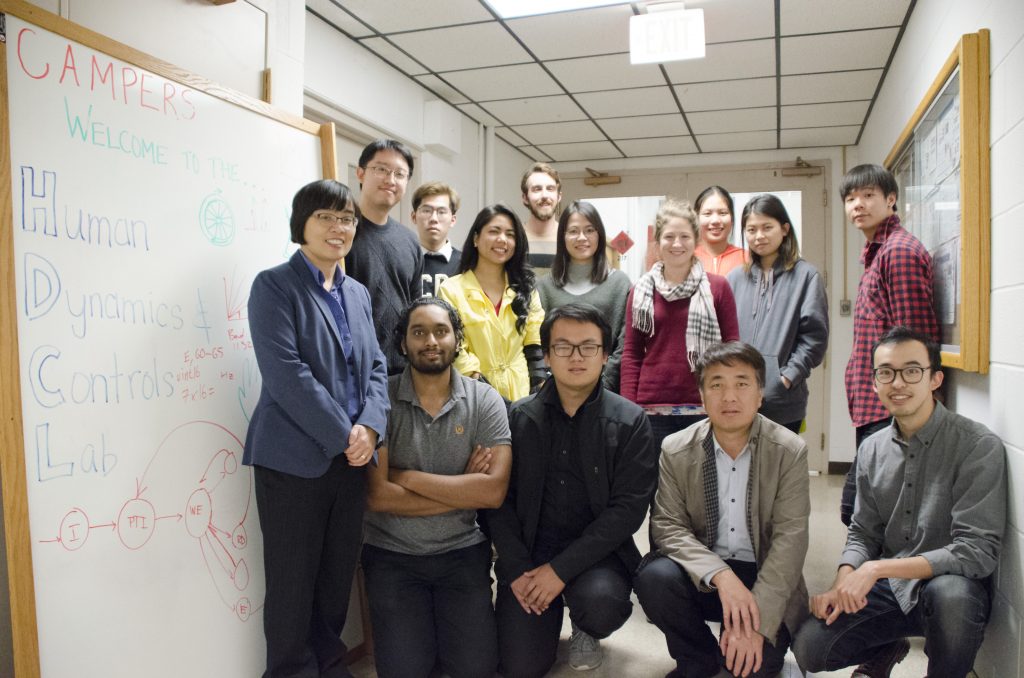Home
The HDCL focuses on investigating and improving movement control and function through two main areas: assistive device development and locomotion biomechanics.
The HDCL’s interest in assistive device development stems from a desire to improve function and the quality of life of persons with disability. To address these areas, we have been involved in the development of powered orthotic devices and multi-speed wheel systems for manual wheelchairs.
Significant investments in research and funding have afforded amputees revolutionary breakthroughs in powered prosthetics. In contrast, advances in orthotics have generally been neglected and powered orthotic (exoskeleton) research is in its infancy – despite vastly more people disabled due to impaired limb function as a consequence of neuromuscular pathology or injury. Compared to powered prosthetic devices, which support actuation and power systems within the space of a missing limb, powered orthotics has a substantial challenge of supporting these systems on the outside of existing but weakened limb. Our group is interested in addressing issues of bulk, weight, control, and runtime, which are significant barriers for the development and use of portable powered orthotic devices. Funding as a testbed for the NSF Engineering Research Center for Compact and Efficient Fluid Power (CCEFP) has motivated us to develop powered orthoses to demonstrate barriers and opportunities in compact, untethered fluid power orthotic devices.
To address the huge pain and injury rates (~70% of users) due to large loads placed on the upper extremities during manual wheelchair propulsion, the HDCL has worked on the development of multi-speed wheel systems with an automatic transmission that are a simple retrofit to a user’s chair. This work has won a number of design competitions, received funding from the NCIIA and NIH/SBIR, and spun off into a small business (IntelliWheels, Inc).
In terms of locomotion biomechanics, the HDCL has been working on developing new measurement tools to better quantify movement patterns and utilizing these tools to understand movement biomechanics of clinical and workforce populations. Support from the NSF led to new techniques to quantify the complex spatiotemporal relationships observed during movement and locomotion. These techniques use data collected by motion capture technology to better quantify changes in movement symmetry, timing, complexity, variability, and coupling. Through two grants from the US Department of Homeland Security and in collaboration with the Illinois Fire Service Institute, we have been examining how firefighting gear (clothing, air packs, tools) and fatigue affect mobility and fall risk. Falls and loss of balance are a leading cause of traumatic injuries among firefighters. To conduct locomotion biomechanics research on firefighters in simulated fireground environments, we have had to establish methods to characterize possible changes in mobility and fall risk without the use of full-body motion data and within tight time constraints and constrained operational environments. With these new movement analysis methods, we are positioned to continue addressing research questions related to gear and fatigue that face firefighters, other first responders (such as hazmat teams), and possibly the military.
Lab News
05/2019- Congratulations to Leo Song for finishing his Master’s thesis titled: “Quantification of spasticity and rigidity for biceps and triceps using the PVRM (position, velocity, and resistance meter)”
05/2019- Congratulations to Ayush Sinha on graduating with his Master’s degree
04/2019- Congratulations to Leo Song for presenting at the Design of Medical Device Conference in Minneapolis
07/2017- Congratulations to Chenzhang Xiao for finishing his Master’s thesis titled: “Pneumatic ergonomic crutches”
07/2017- Congratulations to Austin Chen for finishing his Master’s thesis titled: “Inappropriate posture: Device to Regain Awareness on Postures and Prevent Trauma, Case Study: How Can Young Adults’ Posture Be Monitored Discreetly By Sensing and Movement Assistive Technology”
07/2016- Congratulations to Matt Petrucci for successfully defending his dissertation titled: “Modulation and Modeling of Anticipatory Postural Adjustments for Gait Initiation in Persons with Parkinson’s Disease”
07/2016- Congratulations to Carrie Liang for finishing her Master’s thesis titled: “Design of a Passive Hydraulic Simulator for Abnormal Muscle Behavior Replication”
06/2016- Congratulations to Ziming Wang for finishing his Master’s thesis titled: “Design of Actuation System and Minimization of Sensor Configuration for Gait Event Detection for Gen 3.0 Portable Powered Ankle-Foot Orthosis (PPAFO)”
04/2016- Congratulations to Alan Gaglio, Ziming Wang, Carrie Liang, and Chen-Zhang Xiao for presenting at the Design of Medical Device Conference in Minneapolis
04/2016- Congratulations to Matt Petrucci for finishing his Master’s thesis titled: “Evaluation of Gait Kinematics and Kinetics Using a Powered Ankle-Foot Orthosis for Gait Assistance in People with Multiple Sclerosis”
03/2016- Congratulations Jason Troutner for winning St. Louis University “Real” Elevator Pitch Competition through his new startup Cast21.
02/2016- Congratulations to Matt Petrucci for being acknowledged by the MechSE Department as a 2015 Distinguished Graduate Student in for publishing 6 papers.
02/2015- Congratulations to Mazhar Islam on successfully defending his dissertation titled: “Studies on Gait Control using a Portable Pneumatically Powered Ankle Foot Orthosis (PPAFO) during Human Walking ”
01/2016- Congratulations to HDCL alumnus Scott Daigle on being named to Forbes 30 under 30
12/2015- Congratulations to Morgan Boes on successfully defending her dissertation titled: “Portable Power Supply Efficiency and Gait Assistance Evaluation using a Pneumatic Ankle-Foot Orthosis Testbed”
10/2015- Matthew Petrucci presents his ankle-foot orthosis work in Parkinson’s Disease populations at the Northwestern University Prosthetics-Orthotics Center (NUPOC)
10/2015- Ziming Wang presents his ankle-foot orthosis work in a MechSE BIG Seminar
08/2015- Congratulations to Matthew Petrucci on successfully passing his preliminary examination
07/2015- Congratulations to Mazharul Islam on successfully passing his preliminary examination
02/2015- Congratulations to undergraduate Emily Matijevich for being named a Knight of St. Patrick
01/2015- Movement disorder simulator project within the HDCL funded through Jump ARCHES [Applied Research for Community Health through Engineering and Simulation]
